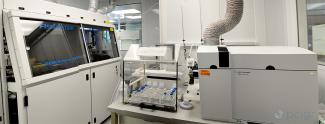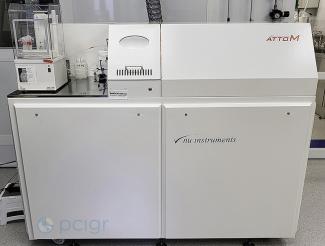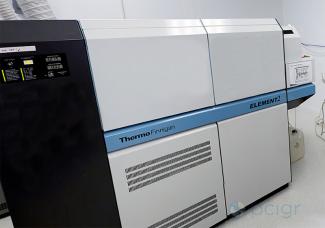PCIGR’s quadrupole and high-resolution ICP-MS instruments are configured to measure trace elements at ultra-low concentrations and/or lead (Pb) isotopic ratios at high-precision. We can provide analysis on a wide variety of sample media, from rocks and minerals to water and biological materials.
|
Make/model |
Configuration |
Services |
|
Quadrupole |
||
|
High-resolution magnetic sector |
||
|
High-resolution sector field |
* Each of our ICP-MS can be coupled to a split-stream laser ablation system
Agilent 7700x

Agilent 7700x quadrupole ICP-MS and RESOlution M-50-LR laser ablation system in the nUBC facility at PCIGR. Photo: D. Weis.
Installed at PCIGR in 2010, the Agilent 7700x is a single-quadrupole ICP-MS that is equipped with the following features:
- Cetac ASX-500 autosampler
- Frequency-matching RF generator
- Collision/reaction cell (He mode) for higher sensitivity, lower backgrounds, and effective removal of polyatomic interferences in complex sample matrices
The Agilent 7700x is used for analyzing trace elements (parts per million to billion range, ppm–ppb), in solution or in situ, in a variety of materials, including:
- Rocks
- Minerals
- Water
- Organic matter (e.g., honey, animal tissue)
- Culture media
For in-situ trace element analysis of solid samples, the Agilent 7700x is connected to an Resonetics RESOlution M-50-LR excimer laser ablation system.
For simultaneous measurement of trace element concentrations and isotope ratios on the same sample run, we use split-stream laser ablation ICP-MS. This technique connects both the Agilent 7700x and a Nu Instruments AttoM ICP-MS to the RESOlution laser ablation system.
Contact Vivian Lai for details on instrumentation and submitting samples.
Consult the Fees page for analytical costs.
Nu Instruments AttoM
The AttoM is used for analyzing trace elements and isotope ratios, in solution or in situ, in a variety of materials, including:
- Pb isotopes in seawater, ice, honey, fish
- Trace elements in rocks
For in-situ isotope ratio analysis of solid samples, the AttoM is connected to an Resonetics RESOlution M-50-LR excimer laser ablation system.
For simultaneous measurement of trace element concentrations and isotope ratios on the same sample run, we use split-stream laser ablation ICP-MS. This technique connects both the AttoM and an Agilent 7700x ICP-MS to the RESOlution laser ablation system.
Contact Vivian Lai for details on instrumentation and submitting samples.
Consult the Fees page for analytical costs.
Thermo Scientific Element 2
The Element 2 can analyze a wide suite of trace elements (including REEs, HFSEs, or both) in solution, in a variety of sample materials, including:
- Rocks, and standard reference materials in rock matrices
- Minerals
- Sediments
- Mine tailings
- Water
- Organic matter
- Pharmaceuticals
The Element 2 can also be connected to an Elemental Science Lasers/New Wave Research NWR193UC laser ablation system for the following in-situ analyses:
- U-Pb geochronology of zircon and monazite
- Trace elements in garnet
For simultaneous measurement of Hf isotope ratios and U-Pb geochronology on the same sample run, we use split-stream laser ablation ICP-MS. This technique connects both the Element 2 and a Nu Instruments Nu Plasma ICP-MS to the NWR193UC laser ablation system.
The Element 2 is also used extensively at PCIGR for QA/QC, as follows:
- Lab blanks
- Reagent blanks
- Column calibration
- Exact elemental contents of samples prior to analysis by multicollector ICP-MS
Contact Vivian Lai for details on instrumentation and submitting samples.
Consult the Fees page for analytical costs.

